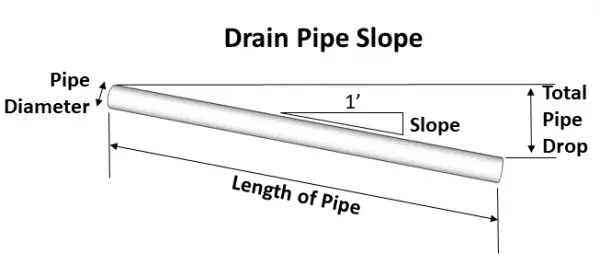This drain pipe slope calculator will calculate the required minimum slope, grade, and total drop (fall) of a drainage pipe over a specified length of pipe. It can be used for building the proper pitch into a plumbing drainage system in a bathroom, kitchen, or even outdoors for rain water drainage.
Just a heads up, this page contains affiliate links. If you buy through them I earn a small commission. If you chose to buy through these links I truly thank you for your support! – Jake
DRAIN PIPE SLOPE CALCULATOR
Drain Pipe Anatomy
The following diagram lays out the different terms that are used in the calculator:

How to Use the Calculator
First, figure out the diameter of the pipe you are working with. For household sinks, the drain pipe diameter is often either 1.5″ or 2″. Toilet waste lines are often 3″ or 4″. All the fixtures in your house will connect to a main drain line, which is usually 4″ in diameter.
If you need to know the thickness, outside diameter or inside diameter of a PVC pipe, check out this calculator.
Next, measure the length of the pipe you are working with. This will allow the total pipe drop (or fall) to be calculated. If you just want to see the required slope per foot, skip this step.
Hit calculate to see the results.
If you want to make things really easy when getting the proper pitch, get yourself a digital level. It will automatically calculate the angle of any pipe you put it on top of.
International Plumbing Code
The slopes given in the calculator vary based on the diameter of the pipe. The International Plumbing Code states what the minimum slopes should be for different size pipes.
According to the International Code Council, 37 states follow the International Plumbing Code. If you live in one of the following states that does not follow the IPC, please check with your local state code for the required drainage slopes:
Alaska—California—Idaho—Kentucky—Main—Massachusetts—Minnesota—Montana—New Jersey—North Dakota—Oregon—South Dakota—Wisconsin
Tips on Calculating Drain Pipe Slopes
- Use the longest level possible for your application for the best accuracy
- When the bubble on a level is about 1/4 of the way past the line it is about a 1/4″ slope. Same logic with 1/8″ slope, 1/16″ slope, etc.
Indoor Plumbing
- Dry fit PVC/ABS components first to ensure there is enough space to properly slope the entire pipe
- Check out the pros and cons of ABS vs PVC pipe here
- A slight rotation of the end fitting (elbow or tee) may be necessary to accommodate a sloped pipe
French Drains
- To calculate gravel for a French drain check out the French drain calculator
- After calculating total pipe drop, ensure the end of the French drain will drain to daylight and not end underground
- Make the trench deep enough to bury the whole pipe (except for the end)
- Weigh down pipe before back-filling to prevent pipe from lifting
FAQ
Why do different diameter drain pipes require different slopes?
A smaller pipe requires a greater pitch. This is because smaller diameter pipes are inherently more prone to clogging and back-ups. Larger pipes can also handle an increased volume of water which helps carry solid waste away so less slope is necessary.
Is there a maximum slope for drainage pipes?
According to the International Plumbing Code, no. Although, some plumbers argue that too much of a slope will allow the water to “pass by” the solid waste and create poor drainage.
Are there any exceptions to the required minimum slopes?
Yes. According to the International Plumbing Code, “except that where the drainage piping is upstream of a grease interceptor, the slope of the piping shall be not less than 1/4 inch per foot (2-percent slope).”
Some other codes also have exceptions for certain urinal drainage systems.
When installing a drain pipe, always make sure it has the proper slope throughout the length of the pipe to prevent backups and overflows. Ensuring this will keep your plumbing system healthy and keep you happy.

